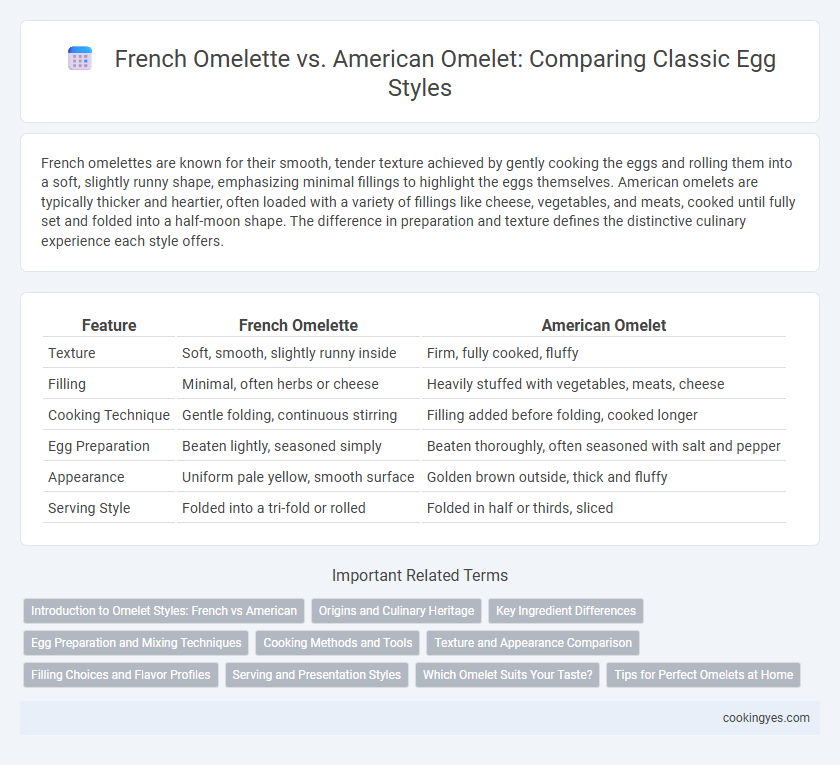French omelettes are known for their smooth, tender texture achieved by gently cooking the eggs and rolling them into a soft, slightly runny shape, emphasizing minimal fillings to highlight the eggs themselves. American omelets are typically thicker and heartier, often loaded with a variety of fillings like cheese, vegetables, and meats, cooked until fully set and folded into a half-moon shape. The difference in preparation and texture defines the distinctive culinary experience each style offers.
Table of Comparison
| Feature | French Omelette | American Omelet |
|---|---|---|
| Texture | Soft, smooth, slightly runny inside | Firm, fully cooked, fluffy |
| Filling | Minimal, often herbs or cheese | Heavily stuffed with vegetables, meats, cheese |
| Cooking Technique | Gentle folding, continuous stirring | Filling added before folding, cooked longer |
| Egg Preparation | Beaten lightly, seasoned simply | Beaten thoroughly, often seasoned with salt and pepper |
| Appearance | Uniform pale yellow, smooth surface | Golden brown outside, thick and fluffy |
| Serving Style | Folded into a tri-fold or rolled | Folded in half or thirds, sliced |
Introduction to Omelet Styles: French vs American
French omelettes feature a smooth, tender texture achieved by gently cooking beaten eggs until just set, often rolled or folded with minimal fillings like herbs or cheese. American omelets tend to be thicker and firmer, cooked thoroughly with a variety of fillings such as vegetables, meats, and cheeses folded inside. Both styles showcase unique culinary techniques and ingredient combinations that define their distinct omelet identities.
Origins and Culinary Heritage
The French omelette, originating from classic French cuisine, is known for its smooth, tender texture cooked over low heat, emphasizing subtlety and technique rooted in centuries of culinary tradition. In contrast, the American omelet reflects a diverse heritage influenced by immigrant cultures, characterized by a fluffier texture and a customizable filling that showcases bold flavors. Both styles celebrate unique cultural identities through distinct preparation methods and ingredient choices.
Key Ingredient Differences
French omelettes typically use whole eggs beaten gently and cooked slowly with butter, resulting in a smooth, tender texture and minimal fillings such as fine herbs or cheese. American omelets often incorporate beaten eggs mixed with milk or cream to create a fluffier, thicker base, filled generously with various ingredients like vegetables, meats, and cheeses. The key ingredient difference lies in the French emphasis on egg texture and subtle seasoning, versus the American style's richer, heartier filling composition.
Egg Preparation and Mixing Techniques
French omelettes are prepared using whole eggs lightly beaten to maintain a delicate, smooth texture, and cooked over low heat with constant stirring to create a tender, velvety consistency. In contrast, American omelets involve vigorously beating eggs until frothy, then cooking over medium-high heat without stirring to produce a thicker, fluffier texture that holds fillings within folded sections. The French technique emphasizes minimal mixing and gentle heat, while the American style relies on more aggressive whisking and higher temperatures for distinct texture and structure.
Cooking Methods and Tools
French omelettes are cooked quickly over medium-high heat using a non-stick skillet and a rubber spatula to create a smooth, tender texture with minimal browning. American omelets are typically cooked at medium heat in a larger, heavier pan, allowing the eggs to brown slightly and be folded over a variety of fillings. The French technique emphasizes continuous stirring and rolling for a silky finish, while the American method prioritizes thicker, hearty folds with a firmer texture.
Texture and Appearance Comparison
French omelettes boast a smooth, silky texture achieved through gentle folding and minimal browning, resulting in a pale yellow, slightly creamy surface with a tender, custard-like interior. American omelets display a firmer, fully cooked texture with a golden-brown exterior due to longer cooking times and often incorporate fillings enveloped within a thicker, more robust form. The French style emphasizes delicacy and a seamless, fold-over presentation, while the American style prioritizes hearty fillings and a visually well-defined, rounded shape.
Filling Choices and Flavor Profiles
French omelettes feature a smooth, tender texture with minimalist fillings like fine herbs, cheese, or mushrooms, emphasizing delicate flavors and subtle aroma. American omelets offer a thicker, fluffy texture packed with bold fillings such as cheddar, bell peppers, onions, ham, and tomatoes, resulting in a hearty, savory flavor profile. The French style prioritizes simplicity and elegance, while the American style showcases diverse, robust taste combinations.
Serving and Presentation Styles
French omelettes are traditionally served folded into a smooth, silky, and slightly runny texture, often garnished with fresh herbs like chives or parsley for a delicate presentation. American omelets are typically cooked to a firmer consistency, folded over a hearty filling of cheese, vegetables, and meats, and presented as a thick, substantial dish. The French style emphasizes minimalism and elegance, while the American style highlights abundance and customization.
Which Omelet Suits Your Taste?
A French omelette features a smooth, tender texture with lightly cooked eggs folded into a soft, slightly runny center, ideal for those who prefer delicate flavors and a creamy consistency. An American omelet is fully cooked with a fluffier texture, often filled with a variety of ingredients like cheese, vegetables, and meats, catering to those who enjoy hearty, robust tastes. Choose a French omelette for elegant simplicity or an American omelet for a customizable, filling meal.
Tips for Perfect Omelets at Home
Achieving the ideal French omelette requires gentle stirring and low heat to create a tender, slightly runny interior with a smooth, unbrowned exterior, emphasizing texture and simplicity. In contrast, the American omelet benefits from higher heat and a fully cooked base, allowing for fillings like cheese, vegetables, and meats to be folded inside for a heartier experience. Using fresh eggs, precise heat control, and proper pan technique are essential tips for mastering both styles and ensuring perfect omelets at home.
French Omelette vs American Omelet for Omelet Styles Infographic

 cookingyes.com
cookingyes.com